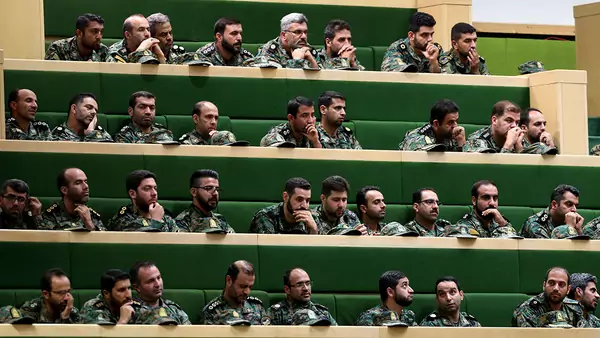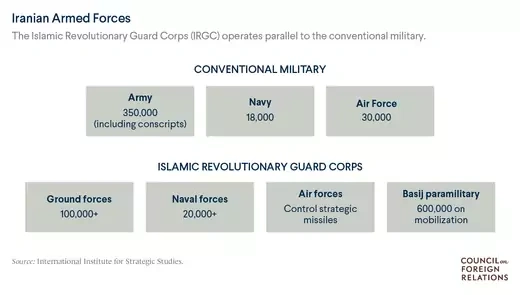 The Islamic Revolutionary Guard Corps (IRGC) was founded as an ideological custodian of Iran’s 1979 revolution. Charged with defending the Islamic Republic against internal and external threats, the corps has gained an outsized role in executing Iran’s foreign policy and wields control over vast segments of the economy. The IRGC’s ties to nonstate armed groups in the region, such as Hezbollah in Lebanon, help Iran compensate for its relatively weak conventional military forces. Answering directly to the supreme leader, the corps is also influential in domestic politics, and many senior officials have passed through its ranks.
The Islamic Revolutionary Guard Corps (IRGC) was founded as an ideological custodian of Iran’s 1979 revolution. Charged with defending the Islamic Republic against internal and external threats, the corps has gained an outsized role in executing Iran’s foreign policy and wields control over vast segments of the economy. The IRGC’s ties to nonstate armed groups in the region, such as Hezbollah in Lebanon, help Iran compensate for its relatively weak conventional military forces. Answering directly to the supreme leader, the corps is also influential in domestic politics, and many senior officials have passed through its ranks.In April 2019, U.S. President Donald J. Trump designated the IRGC a foreign terrorist organization, saying that it “participates in, finances, and promotes terrorism as a tool of statecraft.” It was the first such designation of a state security agency, but the IRGC had already been heavily sanctioned.
Guardians of the Revolution
The IRGC was founded in the immediate aftermath of Shah Mohammad Reza Pahlavi’s fall, as leftists, nationalists, and Islamists jockeyed to set the course of the revolutionary republic. While the interim prime minister controlled the government and state institutions such as the army, many clerics and disciples of Ayatollah Ruhollah Khomeini organized counterweights to those inherited institutions. Among them was the IRGC, which operated beyond the bounds of the law and the judiciary. Answering to Iran’s supreme leader, its command structure bypassed the elected president.
The guards were conceived as a “people’s army,” helping consolidate the revolution as Khomeini, the founding supreme leader, instituted a state based on the concept of velayat-e faqih, or guardianship of the jurist. The aim was to set up Iran as a constitutional republic, enveloped in a theocratic structure. Khomeini intended for the IRGC to protect the new regime from a coup d’état, such as the one in 1953 that ousted the democratically elected government of Mohammed Mossadeq and restored the shah to power.
The Iran-Iraq War (1980–1988) transformed the IRGC into more of a conventional fighting force, in which it adopted a command structure similar to that of Western militaries. Now highly institutionalized, it remains a force parallel to that of Iran’s regular armed forces, with upward of 125,000 troops under its command, according to the International Institute for Strategic Studies (IISS). Its branches include
ground forces based across Iran’s thirty-one provinces and Tehran, which number more than one hundred thousand troops;
the Basij paramilitary force, which can mobilize some six hundred thousand volunteers;
naval forces, separate from the naval branch of Iran’s regular military, which have some twenty thousand sailors and are charged with patrolling Iran’s maritime borders, including the Strait of Hormuz, through which nearly one-fifth of the world’s crude oil and petroleum products transit, according to the U.S. Energy Information Agency;
an air force, also separate from a parallel branch of the regular military, which runs Iran’s ballistic missile program; and a cyber command, which works with IRGC-affiliated businesses on military and commercial espionage, as well as propaganda distribution, according to IISS (its precise relationship with state-affiliated hackers is unclear).

International Activities
As the IRGC first deployed abroad in the Iran-Iraq War, it began sponsoring nonstate armed groups in the region. The expeditionary Quds Force emerged as the IRGC’s de facto external affairs branch, and it has developed ties with armed groups in Afghanistan, Iraq, Lebanon, the Palestinian territories, and elsewhere, providing them with training and military advice to project its power abroad.
By cultivating the Lebanese Shia movement Hezbollah, Iran sought to export its revolution, and later, maintain a deterrent against Israeli aggression. Hezbollah shared revolutionary Iran’s hostility toward the United States and Israel, which occupied southern Lebanon at the time. The 1983 bombings of the U.S. embassy and U.S. Marine and French paratrooper barracks in Beirut, as well as assassinations of regime opponents, have been attributed to Iranian operatives. They are also suspected in the 1994 bombing of a Buenos Aires Jewish center, an accusation Iran denies.
The IRGC’s involvement in Iraq after the U.S. invasion in 2003 became a particular point of contention between Tehran and Washington. U.S. President George W. Bush, who had previously identified Iran as a member of the “axis of evil,” accused the Quds Force in 2007 of providing roadside bombs to Shia militants to kill American forces, though experts inside and outside the government questioned whether such orders came from the government. The Trump administration has attributed the deaths of 608 U.S. troops in Iraq between 2003 and 2011 to the IRGC.
In the wake of the Arab uprisings in 2011, the Quds Force deployed to Syria. At first Iranian officials claimed the operatives were carrying out a limited mission, defending Shiite shrines; only later did it acknowledge the Quds Force was helping Syrian President Bashar al-Assad suppress the protest movement. As the uprising turned to civil war, the Quds Force served not just as military advisors, but on the front lines—a fact made clear by rising numbers of funerals for paramilitary soldiers and some prominent generals. Many of those who have fought with the Quds Force there are not Iranian, but rather militants from Lebanon’s Hezbollah or Afghan refugees recruited by the IRGC.
In response to the rise of the self-proclaimed Islamic State, Iranian officials expanded the Quds Force’s presence in both Iraq and Syria. They warned that if the Sunni militant group was not defeated there, it would march on Tehran. In Iraq, popular mobilizations of tens of thousands of Shiite militiamen soon eclipsed the national army, which fared poorly amid the Islamic State’s rapid advance in 2014. Many of these militias pledged loyalty to Iran’s supreme leader and were led by commanders who worked with the Quds Force against the U.S. occupation in the prior decade. Abu Mahdi al-Muhandis, an official who led the mobilization, is a dual Iranian-Iraqi national and had served as a Quds Force officer. While the mobilization provided the ground forces that rolled back the Islamic State, the United States provided air power, effectively making the guards and U.S. forces tacit partners. U.S. Secretary of State Mike Pompeo has warned Baghdad against excessive Iranian influence, even as Iraqi officials have come to rely on Iran not just for security, but also for energy and trade.
Domestic Clout
The IRGC has also become a central player in Iran’s domestic politics, becoming what CFR’s Ray Takeyh calls the most important organization in the country. After gaining in power as a counterweight to the 1997–2005 presidency of Mohammad Khatami, a reformist, the number of former guardsmen in political life grew further during the first term of Khatami’s successor, Mahmoud Ahmadinejad. Supreme Leader Ali Khamenei—who led the IRGC during the Iran-Iraq War—has appointed former Revolutionary Guard commanders to top political posts, and former guardsmen in parliament have tended to advocate a hard-line foreign policy, as well as support for developing a civilian nuclear program.
Karim Sadjadpour of the Carnegie Endowment for International Peace wrote in a 2009 study that Khamenei has developed a relationship with the IRGC that is “increasingly symbiotic, politically expedient for the Leader and economically expedient for the guards,” helping compensate for the fact that he lacks Khomeini’s authority [PDF]. “He is their commander in chief and appoints their senior commanders, who, in turn, are publicly deferential to him and increasingly reap benefits by playing a more active role in political decision making and economic activity,” Sadjadpour writes.
In 2007, the Basij was brought under the direct command of the IRGC, a reorganization some analysts attributed to a renewed focus on perceived internal threats to the regime. In June 2009, the IRGC was alleged to have helped fix the presidential election in Ahmadinejad’s favor. Amid mass demonstrations alleging fraud, human rights groups documented the Basij attacking protesters. Thousands were detained, and many reformist politicians and activists imprisoned.
The IRGC again intervened in domestic politics in the 2013 election. While Hassan Rouhani ultimately prevailed over hard-liners favored by many guardsmen, reports indicated that the IRGC created an atmosphere of intimidation ahead of the vote and pressured the Guardian Council, which vets candidates for their ideological suitability, to cull candidates they deemed unacceptable. Among those disqualified was the prominent revolutionary figure Akbar Hashemi Rafsanjani, who was suspected of being too independent of Khamenei.
Economic Powerhouse
Among the political interests guardsmen defend is an economic empire worth perhaps as much as one-third of the Iranian economy. A 2009 RAND report [PDF] found that the IRGC got its start as an economic player when it was charged with rebuilding infrastructure destroyed in the Iran-Iraq War, and the corps has since expanded into many other industries, banking, shipping, manufacturing, and consumer imports among them. Political clout secures for IRGC-affiliated companies no-bid contracts from the state to service the oil sector and develop infrastructure.
These economic activities, RAND found, enrich IRGC officials and fund activities, such as weapons acquisition, covert operations abroad, and Iran’s erstwhile nuclear program, as well as support veterans and the families of killed IRGC members. Public works projects developing Iran’s rural regions build the IRGC goodwill it lacks in urban areas, while providing work for Basij volunteers. When floods devastated rural areas in western Iran in April 2019, volunteer guardsmen took a leading role in relief efforts. In Syria, Rouhani has charged the IRGC with spearheading Iranian reconstruction efforts.
The IRGC also participates in massive black markets. Some analysts say that the spate of U.S. sanctions has benefited the IRGC; as Iranian businesses have been cut off from licit finance and trade, the IRGC has had greater black market opportunities. With the U.S. reimposition of oil sanctions, lifted under the 2015 Iran nuclear agreement, the IRGC will have a renewed opportunity to smuggle petroleum products.
The U.S. Treasury Department designated the Quds Force a supporter of terrorism in 2007, and it imposed further sanctions on Quds Force officials in 2011 after a failed assassination attempt on the Saudi ambassador to the United States. Given that those sanctions were unaffected by the 2015 nuclear deal, the main consequences of Trump’s designation of the IRGC as a foreign terrorist organization will be felt elsewhere in the region, especially in Iraq, where lawmakers and military commanders have regular contact with the IRGC, and Lebanon, where Hezbollah serves in the parliament.
After Secretary of State Pompeo first announced the designation, Reuters reported that the State Department would enforce it selectively, so that foreign officials, firms, and humanitarian organizations in the region will not automatically face penalties or liability for dealings with the IRGC.
No comments:
Post a Comment